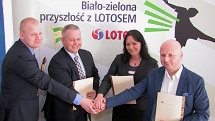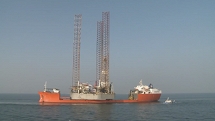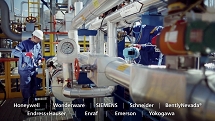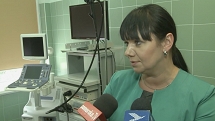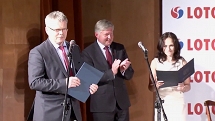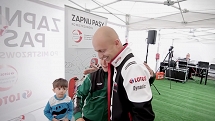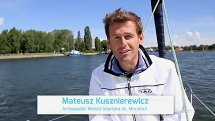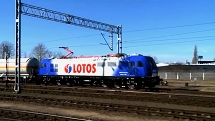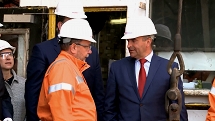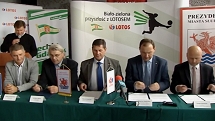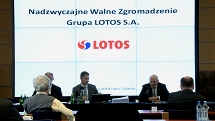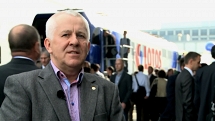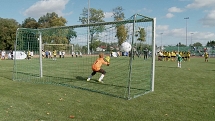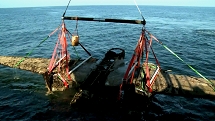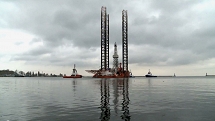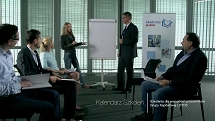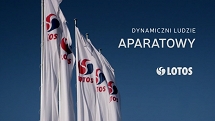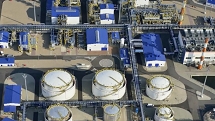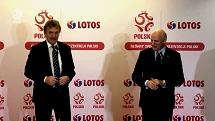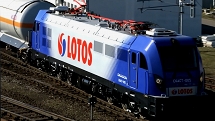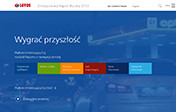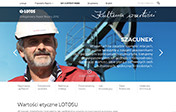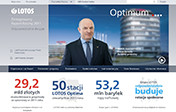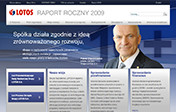-
Financial information
The past year ushered in a series of challenges for the companies in the fuel sector. The decisions made by us have demonstrated that we are able to take rapid steps to adapt to a demanding environment and ensure the desired profitability for our projects.
-
Segment performance
The segmental management model we have implemented enhances management efficiency, delivering cost and revenue synergies across the organization.
-
Letter from the Vice-President of the Board
2014 ushered in a series of challenges for the companies in the fuel sector. The decisions made by the LOTOS Group have demonstrated that we are able to take rapid steps to adapt to a demanding environment and ensure the desired profitability for our projects.
-
Business environment
The key factor that had a strong impact on both the global and Polish petroleum markets in 2014, with significant consequences for the LOTOS Group’s performance, was the price of crude oil, which also determined the price of petroleum products.
-
Strategic objectives
The LOTOS Group’s Strategy is designed to strengthen our position as a strong, innovative and efficient business which plays a major role in ensuring national energy security.
-
Business model
Our operations consist in crude oil production and processing, as well as wholesale and retail sale of petroleum products, among which are: fuels (unleaded gasoline, diesel oil and light fuel oil), heavy fuel oil, bitumens, aviation fuel, naphtha, propane-butane LPG and base oils.
-
Risk and opportunities
At the LOTOS Group, we identify a range of diverse risks, which may affect all areas of our business. The key risks in terms of their impact on our operations are the financial risks as well as risks affecting the exploration and production area. In the analysis of the risks, we also factor in issues related to sustainable development.
-
Key data 2014
With revenue of ca. PLN 28.5bn in 2014, we rank fourth in the group of 500 largest businesses in Poland.

Exploration and production
STATEMENT
2014 brought many positive developments in the LOTOS Group’s upstream segment. However, it was also a time when we had to cope with the implications of the changed business environment, in particular on the global oil market.
Zbigniew Paszkowicz
Vice-President of the Management Board, Exploration & Production, Grupa LOTOS, President of the Management Board, LOTOS Petrobaltic
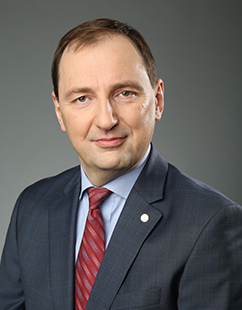
The LOTOS Group’s hydrocarbon production potential doubled last year, following the acquisition of Heimdal assets by LOTOS E&P Norge in December 2013. In February, the ‘GSF Monitor’ rig purchased in late 2013 was deployed in the Baltic Sea. With a capacity to drill to the depth of up to 9,000 m, it is more technologically-advanced than the ‘Petrobaltic’ rig (drilling to the depth of up to 6,000 m). Longer legs make it suitable for operation in areas with water depth of up to 106 m, or even up to 120 m with extended legs. This means that we can use the rig for drilling exploration wells in all our off-shore licence areas. After quick adjustment to the operating conditions in the Baltic Sea, in the spring the new rig, named ‘LOTOS Petrobaltic’, began to drill for oil and gas.
LOTOS Petrobaltic obtained extension of its production licence for the B3 field, from which we will produce oil and gas until 2026, that is ten years longer than assumed under the previous licence and plans. We now estimate that the field will yield one million tonnes of oil more, ensuring steady revenue streams and stable financial position. All this was made possible by our employees’ expertise and experience in optimum hydrocarbon production.
In 2014, we signed an agreement with a consortium of banks and financial institutions for the financing of the development of the B8 field. Another milestone was the successful issue of Grupa LOTOS shares. A significant part of the issue proceeds are earmarked for the development of the B4 and B6 gas fields under a project executed jointly with CalEnergy, our world-class partner.
Last year, we also began onshore exploration activities. We partnered with Polskie Górnictwo Naftowe i Gazownictwo S.A. and signed an agreement on joint operations in the Górowo Iławeckie and Kamień Pomorski licence areas. Together we will carry out 2D seismic surveys.
In Norway, in 2014 LOTOS E&P Norge applied for new exploration licences in the APA 2014 licensing round, and won an interest in a licence as its operator.
In Lithuania, we stabilised oil production by LOTOS Geonafta and LOTOS Geonafta Group companies. It is worth noting that LOTOS Geonafta, the largest oil exploration and production company in Lithuania, with rightful pride and satisfaction celebrated the 50th anniversary of its operations.
The Miliana Group companies and TSM provided effective and efficient offshore logistics services to our rigs. In 2014, strong results were posted by Energobaltic, converting natural gas from the B3 field into LPG and environmentally friendly electricity and heat, which are then supplied to Władysławowo and the neighbouring towns and villages.
Since the second half of 2014, we have been operating under more challenging economic conditions. Given the rapid fall of oil prices on global markets, which started in August 2014, we made a professional assessment of our development plans and budgets, and revised them accordingly. Hydrocarbon exploration and production projects, especially on subsea deposits, are cost intensive and long-term in nature. We reviewed our projections in detail, taking into account the new economic reality and long-term forecasts, according to which oil prices may not return to pre-crisis levels in the years to come.
However, in this new environment we have made a key assumption: LOTOS will not give up investing in hydrocarbon exploration and production. This applies primarily to our strategic projects executed in the Baltic Sea, namely the development of the B8 oil field, and the B4 and B6 gas fields. The projects will be much more challenging and their implementation will require high flexibility, their scopes and deadlines may need to be adjusted to the present market situation, but we shall maintain our resolve to implement them.
Our achievements in 2014, including the ability to react quickly to the rapid changes in the economic environment, are the effect of the qualifications, commitment and hard work of employees of all LOTOS Group companies operating in the upstream segment. In difficult conditions, the value of people is put to a test. The developments in late 2014 again confirmed that people are LOTOS’ most valuable asset.
Grupa LOTOS is engaged in exploration and production through the LOTOS Petrobaltic Group in the following countries:
- Poland – LOTOS Petrobaltic and its subsidiaries (B8 Sp z o.o., B8 Sp. z o.o Baltic SKA, Baltic Gas Sp. z o.o. i Wspólnicy SK, Baltic Gas Sp. z o.o.),
- Lithuania – AB LOTOS Geonafta and its subsidiaries (UAB Minijos Nafta, UAB Manifoldas, UAB Genciu Nafta),
- Norway – LOTOS Exploration and Production Norge AS.
(See more)
The LOTOS Petrobaltic Group includes companies conducting support activities: the Miliana Group, Energobaltic Sp. z o.o. and Aphrodite Offshore Services N.V., based in Curaçao, the Netherlands Antilles (which was dormant in 2014).
The Miliana Group renders sea logistics services to LOTOS Petrobaltic, including crude oil storage and transport, rescue and anti-spill assistance, geotechnical surveying, and intermediary services in organizing air transport services to the rig, using six own vessels: Icarus III tanker, multi-purpose vessels St. Barbara, Kambr and Aphrodite I, Granit and Bazalt tugboats, as well as tonnage chartered from third-party shipowners. In 2014, the services were extended to include those provided by the ‘LOTOS Petrobaltic’ rig.
Energobaltic’s business comprises management of associated gas produced from the B3 oil field and – in the future – from other hydrocarbon accumulations located in the Baltic Sea. At the Władysławowo CHP Plant, the company produces electricity, heat, LPG and natural gas condensate using associated gas from an offshore oil production facility (the B3 field).
Licences in Poland − Baltic Sea
LOTOS Petrobaltic holds:
- licences for the production of crude oil and natural gas from the B3 field,
- through Baltic Gas Sp. z o.o. i Wspólnicy SK – interests in licences for the production of natural gas from the B4 and B6 fields,
- through B8 Sp. z o.o. Baltic S.K.A. – interest in a licence for the production of crude oil and natural gas from the B8 field.
The total area covered by the production licences spans more than 147.84 km2.
LOTOS Petrobaltic holds oil and gas exploration and production licences in the Polish economic zone of the Baltic Sea in the following regions: Gotlandia, Łeba, Rozewie, Gaz Południe, Sambia E, Słupsk W and Słupsk E.
The total area covered by these exploration and appraisal licences is more than 7,300 km2.
In 2014, the company discontinued its exploration activities in the Sambia W region as there were no prospects for oil production, which resulted in the expiry of the relevant licence.
Licences in Lithuania
In Lithuania, LOTOS Petrobaltic conducts its activities through its subsidiary AB LOTOS Geonafta, in which it holds a 99.99% interest (1 share is held by Grupa LOTOS).
The AB LOTOS Geonafta Group comprises:
- UAB Genciu Nafta (a 100% share),
- UAB Manifoldas (a 100% share),
- UAB Minijos Nafta (a 50% share).
The core business of the AB LOTOS Geonafta Group is exploration for and production of crude oil and provision of drilling services in Lithuania. The company is also engaged in crude oil trading. In aggregate, as at the end of 2014 AB LOTOS Geonafta Group companies produced hydrocarbons from 15 onshore oil fields.
Licences in Norway – Norwegian Continental Shelf
LOTOS Exploration & Production Norge AS (LOTOS E&P Norge) of Stavanger, Norway, is the subsidiary responsible for our operations on the Norwegian Continental Shelf.
Following the acquisition of Heimdal assets, LOTOS E&P Norge holds interests in 23 oil exploration and production licences in the Norwegian Continental Shelf, including: PL 498, PL 498B, PL 503, PL 503B, PL 503C, PL 643, PL 655, PL 442 FRIGG GD, PL 362 FULLA, PL 316/PL 316B YME, PL 249 VALE, PL 026 RIND, PL 026B FRIGG GD, PL 035B FULLA, PL 036 VALE, PL 036BS HEIMDAL, PL 102 SKIRNE BYGGVE, PL 102C ALTA, PL 102D, PL 102E SKIRNE, PL 102F TRELL, and PL 102G TRELL.
The company is the operator under seven licences: PL 498, PL 498B, PL 503, PL 503B, PL 503C, PL 362, and PL 035B.
Oil and gas reserves
As at the end of 2014, the LOTOS Petrobaltic Group’s 2P crude oil reserves totalled 6.1m tonnes and 2C resources amounted to 3.985m tonnes. In the Baltic Sea, on the Norwegian Continental Shelf and in Lithuania, 2P oil reserves were 4.9m tonnes, 0.23m tonnes and 0.98m tonnes, respectively, while 2C oil resources were 0.085m tonnes in the Baltic Sea and 3.9m tonnes on the Norwegian Continental Shelf.
Natural gas reserves and resources were 0.9 billion cubic metres (2P) and 6.4 billion cubic metres (2C). In the Baltic Sea and on the Norwegian Continental Shelf, 2P natural gas reserves were 0.39 billion cubic metres and 0.51 billion cubic metres, respectively, while 2C natural gas resources amounted to 3 billion cubic metres and 3.4 billion cubic metres, respectively.
As at December 31st 2014, total crude oil and natural gas reserves and resources amounted to 6.8 million toe (tonnes of oil equivalent) in oil reserves classified as 2P and 9.3 million toe in oil resources classified as 2C.
Crude oil and natural gas production in 2014
In 2014, crude oil was produced from the B3 field in the Baltic Sea, from onshore fields in Lithuania, and on the Norwegian Continental Shelf. The production totalled 305.2 thousand tonnes, including 160.1 thousand tonnes from the Baltic Sea fields, 70 thousand tonnes in Lithuania, and 75.1 thousand tonnes on the Norwegian Continental Shelf. The output was 86 thousand tonnes higher than in 2013 (219 thousand tonnes).
Natural gas was produced from the B3 field in the Baltic Sea and on the Norwegian Continental Shelf. The output totalled 239.2 million cubic metres, including 17.8 million cubic metres from the B3 field, and 221.4 million cubic metres on the Norwegian Continental Shelf. Total output was 222.4 million cubic metres higher than in 2013 (16.8 million cubic metres).
The higher output was in large part attributable to the production assets on the Norwegian Continental Shelf purchased as part of the Heimdal portfolio.
In 2014, the annual crude oil and natural gas output reached more than 500 thousand tonnes of oil equivalent.
Operations in 2014
Development of upstream operations has been a priority under the LOTOS Group’s Strategy for 2011−2015. Our activities in this area are focused on increasing production from own fields and improving the security of oil and gas supplies by ensuring direct access to new hydrocarbon deposits (acquisition of own resources under exploration licences and establishment of cooperation with partners that have access to oil and gas deposits). The following steps were taken in pursuance of this strategic goal in 2014:
In Poland:
- Production from the B3 field
Production of crude oil and associated gas from the B3 field continued. Pursuant to the Ministry of Environment’s decision of May 23rd 2014, the term of the licence for crude oil and natural gas production from the B3 field was extended to 32 years starting from the licence issue date, i.e. until July 29th 2026. - Development of the B8 field
Development work on the B8 field was continued in line with the schedule. Financing was secured by executing project finance agreements between B8 Spółka z ograniczoną odpowiedzialnością Baltic S.K.A. (B8 SPV), Polskie Inwestycje Rozwojowe S.A., Bank Gospodarstwa Krajowego, and Bank Pekao S.A. The Minister of the Environment issued a decision to transfer the licence for production of crude oil and associated natural gas from the B8 field located in the Polish exclusive economic zone of the Baltic Sea from LOTOS Petrobaltic to B8 SPV. A share capital increase through a share issue was registered at the target company, B8. The newly issued shares were fully acquired by LOTOS Petrobaltic and paid for in the form of cash and in-kind contribution, including the right to use geological data of the B8 field, assets produced by LOTOS Petrobaltic for the development of the B8 field, and the ‘Petrobaltic’ drilling rig. - Development of the B4 and B6 gas fields
Preparatory work on the B4/B6 gas fields was continued in partnership with CalEnergy Resources Poland. The process of selection of the development concept was completed: production wells are to be drilled using the ‘LOTOS Petrobaltic’ platform. Work was underway on the front-end engineering design of the onshore and offshore installations and on securing onshore transmission capacities. - Seismic surveys in the Baltic Sea
Intensive exploration and appraisal work was performed in the Polish exclusive economic zone of the Baltic Sea. In 2014, geological work was conducted in all areas covered by LOTOS Petrobaltic’s licences for exploration or exploration and appraisal of crude oil and natural gas. In the Gotlandia and Gaz Południe licence areas geological work was conducted consisting in drilling two wells: the exploration well B27-1 and the appraisal well B21-2. The exploration well proved dry whereas the appraisal well confirmed the presence of gas and condensate in the B21 accumulation on the main tank level – Cambrian sandstones as well as indicated the oil potential on the additional, carbonate tank level. In the remaining five licence areas, design and analytical work was underway. The terms of the Łeba licence were amended and an annex to the working interest agreement was signed. The amendment extended the licence term until December 14th 2016 and changed the scope of geological work. With respect to the Gaz Południe licence, on December 12th 2014 its terms were amended and working interest under the licence was approved. Under the amendment, the licence term was extended until June 14th 2016. The activities we are undertaking are aimed at exploring the oil potential in the licence areas and acquiring detailed data on the geological structure of potential prospects to mitigate the exploration risk before making a decision to drill exploration or appraisal wells. In September 2014, we filed an application with the Ministry of the Environment for an onshore oil and gas exploration and appraisal licence covering the Młynary area, together with the related plan of geological operations. - Cooperation with PGNiG
As part of expanding operations under onshore licences, a joint operations agreement was executed with Polskie Górnictwo Naftowe i Gazownictwo S.A. concerning the Górowo-Iławeckie licence in north-eastern Poland. The cooperation involves the acquisition of a total of 200.4 km of 2D seismic data. Results of the work done are expected to be known in mid 2015. On the basis of those results, a decision will be made whether to proceed with any further work in the Górowo-Iławeckie licence area. The objective of the project is to discover potential oil accumulations in Cambrian formations. Cooperation in this licence area is a continuation of the activities initiated under the agreement on cooperation in exploration activities of April 2013.
The cooperation with Polskie Górnictwo Naftowe i Gazownictwo also takes place in the Kamień Pomorski licence in north-western Poland. In 2014, the cooperation consisted in executing e.g. a 3D seismic survey of the total area covering 110 km2. Results of the survey will be assessed in the mid-2015. On the basis of those results, a decision will be taken whether to drill an exploration well in this licence. The objective of the project is to discover potential oil accumulations in the main dolomite formations and potential natural gas accumulations in the red sandstone (Rotliegend) sediments. The basis for all work in the Kamień Pomorski licence is the agreement on joint operations concluded between PGNiG and LOTOS Petrobaltic in 2013.
In Norway:
- Production from the Heimdal field
Production of gas and condensate from the Heimdal fields (Alta, Vale, and Skirne) continued. Following an overhaul of the Heimdal rig finished in June 2014, the rig’s life was extended until 2034, as confirmed by a relevant certificate issued by the Petroleum Safety Authority Norway. - YME project
Under the YME project, LOTOS Petrobaltic is analysing the possible scenarios of recovering the invested capital. In particular, it is considering an option involving redevelopment of the field. - New licence
The company applied for new exploration licences in the APA 2014 licensing round, and won an interest in licence 797, the operator of which is LOTOS Norge.
In Lithuania:
- Exploration and production
AB LOTOS Geonafta and UAB Genciu Nafta produced crude oil from the Girkaliai, Kretinga, Nausodis and Genciu onshore fields.
UAB Manifoldas produced oil from Auksoras, Liziai, Veziaciai and Ablinga onshore fields, while UAB Minijos Nafta recovered oil from Vilkyciai, Pietu Siupariai, Degliai, Pociai, Sakuciai, Agluonei and Siupariai onshore fields.
In 2014, the AB LOTOS Geonafta Group focused its geological work on appraisal of the oil potential of the Klaipeda block (owned by UAB Manifoldas). Two exploration and appraisal wells and two production wells were drilled. As one of the exploratory wells proved dry, the project was removed from the list of prospects. Production was launched from the remaining wells.
Objectives for 2015
The principal strategic goal for the exploration and production segment is to increase the production potential to 24 thousand boe (barrel of oil equivalent) daily (or 1.2m tonnes of crude oil annually) in 2015. The LOTOS Group’s plans provide for continuous expansion of operations in the Baltic Sea, the Norwegian Continental Shelf and onshore areas in Poland and Lithuania.
We plan to undertake the following key initiatives as part of our strategy:
Poland
- Continued production from the B3 field on the Baltic Sea using the PG-1 rig.
- Continued work on the development of the B8 oil field located in the Polish exclusive economic zone of the Baltic Sea with a view to launching commercial production.
- Exploration and appraisal work to assess the Baltic Sea’s full production potential.
- Further work to develop the B4/B6 gas fields with a view to launching commercial production.
- Further cooperation with PGNIG to participate in the exploration for and appraisal of conventional and unconventional oil and gas resources under onshore licences. The decision whether or not to drill an exploration well will depend on the results obtained.
Norway
- Development of and production from the fields forming part of the Heimdal portfolio.
- Further steps to recover capital invested in the YME project.
- Evaluation of further asset purchase opportunities in the Norwegian Continental Shelf.
Lithuania
- To fully develop our onshore licence areas, a production drilling programme will be implemented.
- Evaluation of possible licence acquisitions in Lithuania.
Development prospects until 2020
Our key focus until 2020 will be to increase the production potential to approximately 100 thousand boe (barrel of oil equivalent) per day, or 5 million tonnes of oil per year, and to secure approximately 330 million boe of proved recoverable reserves.
In 2016–2020, the development focus will be primarily on Poland, where we plan to appraise the full production potential of the Baltic Sea assets. Concurrently, we intend to intensify our onshore activity. On international markets, we plan to build a sustainable asset portfolio and gradually boost organic growth. We are also considering intensifying production from production fields in Poland and Lithuania using the Enhanced Oil Recovery (EOR) technologies.
The development of our exploration and production segment in 2016−2020 in Poland will involve:
- Continued oil production from the B3 and B8 fields on the Baltic Sea.
- Launch of gas production from the B4 and B6 fields on the Baltic Sea.
- Full appraisal of the hydrocarbon potential of the Baltic Sea assets: completion of the seismic survey programme and drilling of exploration and appraisal wells on promising plays.
- Preparation and execution of projects to develop the Baltic Sea areas with confirmed resources.
- Production from onshore fields, expansion of onshore operations through faster development of oil and gas discoveries.
- Assessment of the possibility to intensify production from the production fields in Poland and Lithuania using EOR technologies.
Key areas of focus of international expansion plans for 2016−2020 are to:
- Carry out projects to develop formations with confirmed resources.
- Acquire production assets and undeveloped assets with confirmed resources which can be brought on stream by 2020.
- Continue and increase production activities in Lithuania, e.g. by developing new prospects with confirmed resources.
- Explore development opportunities in new geographical areas.






